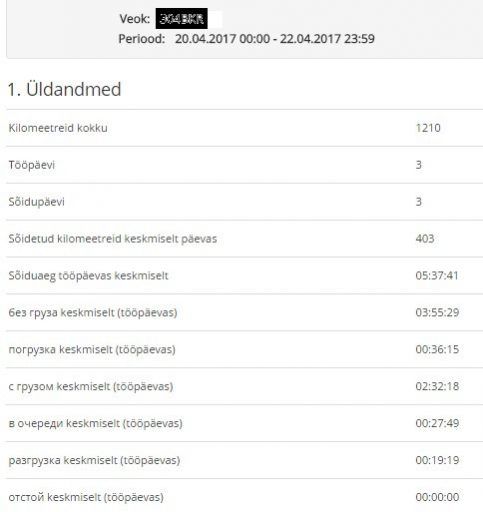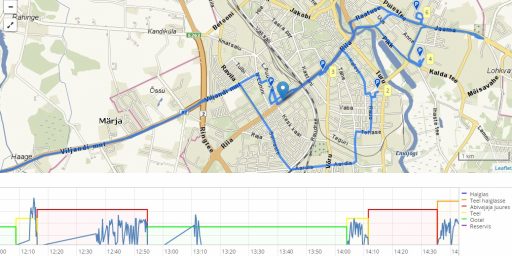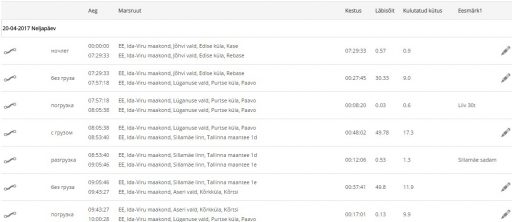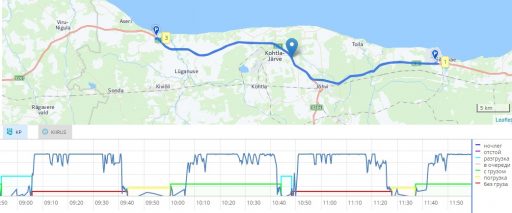Recording of changes in operating status
It is common sense that measures to improve efficiency should be based on careful measurement and analysis. First, the work or service process should be broken down into a succession of operating statuses. The breakdown, definition and number of statuses are likely to be different in each specific case.
It is important to register transitional moments accurately, which can be efficiently achieved by using a keyboard attached to the controller as an accessory. Measurement of the durations of the work statuses enables to understand quite easily what the time was spent on. In addition to the duration, there are mileage in kilometres, consumed fuel, and supporting maps related to each status. Measurement results enable to assess the efficiency of the process, to shape the price of the service, to develop a motivating salary system, and to use the registered statuses as the basis for a work journal. Further analysis of what to do to improve the process based on the registered outcome depends on each specific company.
How has this option benefited our clients?
- A construction company
A construction company has broken down the process of delivery of materials into the following statuses: driving with and without a load, loading and offloading, waiting in a queue, rest time.
The operating status history (which includes the corresponding map data) constitutes a clear and unambiguous record of when and where status changes occurred and how long the status remained unchanged. The history allows to detect delays in the work process. The report states the average daily status durations for the selected period, permitting the company’s manager to conveniently assess the efficiency of operations.

With regard to each status, the report contains a supplementary field in which the user can add additional relevant information. When information is added to the relevant fields identifying the client, the service provided or cargo delivered, the report becomes an operations journal and can be used as input data by an invoicing application. No entry will remain unnoticed, no penny wasted.
The operating status report can be exported for further processing into the customer’s business software. For further reading, see the article Transfers of Data between Systems
- Ambulance
An ambulance service uses operating status data to analyze responses to emergency calls.
The ambulance service has defined the following operating statuses: waiting for an assignment, on its way to a patient, at the patient’s location, on its way to the hospital, in maintenance, in reserve.
The point of departure for the service is the time when an emergency call-out is received by the emergency services call centre. What needs to be done first is to measure the crew’s precise response time and the time it took to reach the destination. These will be reflected in operating status changes.
The process of responding to the call-out is subsequently scrutinized and operational performance is analyzed. The crews go through this routine on a constant basis, subjecting every delay to critical examination. This ensures better preparedness and a reduction of response times.
In addition, the dispatcher can also see the real-time operating status of the ambulance crew, indicated by the colour of the dot representing them on the map.
- Fuel hauling company
It is in the interest company of the fuel hauling to have its tankers offload the fuel at the petrol stations as quickly as possible.
It is equally important to be able to easily verify the location and time of offloading. This does not require a keyboard – signal leads connected to the controller’s inputs will show when the offloading pump is switched on and when the trailer’s side hatch is opened. With a mouse click on the relevant line in the report, the logistics dispatcher can easily verify whether the offloading pump’s operational cycle (i.e., the offloading site) corresponds to the customer’s location.
Reports concerning the status changes of the offloading pump and the trailer’s side hatches are automatically sent to the company’s business software which compares them to the offloading time assigned by the Customer Orders / Sales module. As a result, any offloading operations that exceed the assigned time-limit are highlighted. Faster offloading reduces the tankers’ stationary time which in its turn translates into better hauling performance – which means increased profits for the company and better pay for the driver.
- Timber hauling company
For a timber hauling company, it is of crucial importance to maximize the number of customers served during a business day.
In addition to the time spent on road, it is important to know the time that it takes to load and offload cargo by means of the truck’s loading crane and what proportion of the total time spent at the site is taken up by the loading/offloading operation. In order to measure the duration of the work performed while the vehicle is stationary, the device is wired to receive signals from the hydraulic pump and the crane. The device consistently records changes in the operating status of both mechanisms. The report reveals the periods during which the hydraulic pump operates without a load, suffering needless wear and tear. If it appears to take too much time according to the report, the particular operation will be scrutinized separately and, if necessary, adjustments will be made to the work process to reduce the loading/offloading time and improve the general efficiency of the service. The map data linked with the operating status allows dispatchers to check whether or not the offloading occurred at the right address and/or at the time agreed with the customer.
You may also be interested in:
-

What are the benefits of GPS tracking?
The availability of up-to-date and precise information is a prerequisite for good management. Old- school types find that to determine the location of a person or a vehicle, you can simply call them.
Read more -
Transfer of data from one system to another
This is handled by Webservice which is a piece of software intended to link up different applications or systems. Webservice comes into play when data gathered by different applications need to be exchanged or when data gathered by one application need to be transferred to another for further post-processing.
Read more -

Monitoring service hours, GPS tracking of heavy equipment
With a heavy equipment fleet, the two largest expense items are fuel costs and depreciation due to wear and tear of the equipment. How can these expenses be kept in check most effectively? But of course, the best answer can be found in GPS tracking. Its uses can be much wider-reaching and varied than mere checking whether a vehicle’s engine is currently running or turned off. Unobtrusively and subtly, GPS tracking keeps an eye on the fleet’s main expenses and triggers a notification when and where needed.
Read more




